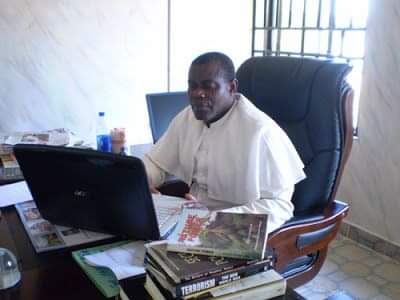By Terver Adom
In 1997, the parishioners of St Thomas Parish Gboko South then the larger Makurdi Diocese waited in anticipation to receive Rev Fr Christopher Ierwua Utov from St Christopher’s parish Wannune. This announcement signaled the end of the era of Rev Fr (major) Peter Malu as the parish priest and was to mark the beginning of another in the parish.
St Thomas Church Gboko South was raised to the status of a parish on June 14, 1980 by Rt Rev Dr. Donald Murray of blessed memory, then the Bishop of Makurdi Diocese. Before this time, it was an outstation of St. John’s Parish ( now St John the Baptist cathedral) Gboko under the late Fr. Simon Ivever. Rev Fr. Augustine Asen was in charge of the church preparatory for its attainment of a parish. History remembers late Gabriel IBU who was a prison officer and would bring inmates to work in the church premises. Others that contributed so much to the material needs of the church included Mr Philip Bulya, Daniel Anusa, Patrick Agashua, David Ansha, Vincent Abari, Mrs Eunice Kukwa and Catechist Mathias Mishi who served as the parish catechist from 1980 until his death some years ago.
Rev Fr Richard Tule became the first parish priest in 1980 until 1986. He was succeeded by Oliver Tarkende. Tarkende later around 1992/1993 had an ugly experience with his parishioners that led the temporary closure of the parish. He has remained the longest serving parish priest having served up to 1997. He was succeeded by Peter Malu. Malu spent just about six months and the parish experienced military parish administration. I think this was calculated to avoid the confrontation of his predecessor by his parishioners.
With the reports of the coming of Fr Chris Utov, a man who was an exorcist many stories were said of him. It was even rumoured that some powerful men and women fled the church on his arrival because they had acquired ‘ikyav’ and Fr Utov was renowned for collection and destruction of ‘lkyav’. With Utov as the parish priest, he continued with his masses for the sick that attracted people from far and near, catholics and non catholics, Christians and pagans, rich and the have not to the parish. The following year of his arrival, I learnt catechism and received the sacraments of penance and Eucharist known as first holy Communion. With this development I was frequent to church activities and would often visit the store where deistical equipments were collected and kept. These ‘kyav’ increased after every mass for the sick.
It was during this period that I got to see ‘ikyav mbi mbatsav’ like ‘iyô mbatugh’. This deistic article is owned by a member of a community in trust and it is used in enforcing decisions or to compel respect for taboos and prohibitions for good governance in the community. A person who refuses to obey decisions or who is found guilty of contravening the prohibitions in the society is bitten to death through the medium of this snake. In this store too I saw , ‘tsue mbatugh’. This is used by a payer of a flesh debt, having killed his victim, goes to the chain expert and pays him his fee; the latter then proceeds to the grave and whirls his chain round several times with the result, it is claimed that a whirlwind arises which gradually increases in intensity till it causes the earth covering the corpse to fall apart, leaving the body exposed. The chain is then thrown over the body and corpse dragged out of the grave and taken to ‘kpande or’. This ‘kpande’ was one of the items in the store. The use of this kpande translated as slaughter-mat is an article upon which the body of a dead man who is meal for mbatsav is dismembered and the head cut off. The carver, ‘ or u burun’ and his assistants who hold the body still and finally the sharer-out of the flesh ‘ or u Karen kwar’ would perform his duty. Human flesh ‘lkpindi’ is not eaten in a common meal. But everyone removes his own portion to his house where he shares it with his wife if she is a member of the ‘mbatsav’. The head is the perquisite of the one providing the victim.
Fr Utov once collected ‘nyinya-mbatugh’. The night horse is a small model of a horse sometimes made of clay and covered with cloth and sometimes of metal. The mbatsav mounts this horse at night, travel immense distances invisibly, kill their victims, and return safely. The list of those ‘ikyav’ is endless. There was one that was nicknamed ‘Dooshima Utov’. It was like a doll though it was made of clay but with constant blinking eyes. It was brought by a lady mbatsav. According to the story it was meant to bring good luck to the lady. She would command men to obey her and she was offering her children as sacrifices to keep the doll effective but got tired as she had no children to offer.
In essence, Utov was an anti-mbatsav movement himself. He freed so many souls from bondage and led men closer to God. He will be remembered for so many things but I have chosen to reflect on his anti-mbatsav movement.
Fr Utov, may you rest in peace.
Editor’s note: First published on Terver Adom Facebook page in 2017



